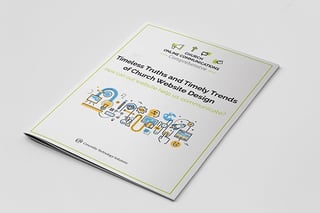
In this week's session of the Church Online Communications Comprehensive, we're going to switch our attention from the theoretical to the practical. We've spent enough time talking strategy; now it's time to get into the practical implementation. Let's start off by discussing church websites.
When the topic of church websites comes up in the discussion of online communications, it's hard to do it justice in only a couple weeks. While I'm going to focus on the highlights, it's important to remember that this will only be a sample of the many different best practices that can be applied to your church's website.
A Long Time Ago in a Congregation Not So Far Away...
I built my first church website in 2001. I was a teenager working with another kid who was a few years older than me. He had experience building websites, meaning he had been doing it for a couple years. While the internet had been available to consumers for several years at that point, it was still a new concept for many people (especially for churches).
The two of us worked with our church's Board of PR Communications, a group of adults from various backgrounds. What they lacked in technical expertise they made up for with professional experience in communication, and they did a great of job of guiding and teaching those communication principles.
The Center of Your Church's Online Communication
We built that website using Microsoft Frontpage, a tool that generated HTML code based on a drag and drop editor. It was clunky at best, and while I didn't like that it did the coding for me (I spent a lot of time learning HTML), it worked well for us.
That tool has since been replaced multiple times (remember Adobe Flash?), and while true web programmers still know how to code, it's certainly not a necessity for the average person. However, as I look back and realize how different web technologies are today, there are many things about church web design that hasn't changed.
Here are three things that haven't changed in the last 16 years and three things that certainly have.
Timeless Truths
- Audience Focused
Your church website should serve as the digital communication center for your church, but if you don't focus on your audience, it will never be more than an online bulletin board, or in other words, a place where announcements go to die. Good communication has always been audience-focused, and as websites became commonplace, it was no different. The kind of people who visit your site and the information they are looking for will be different than someone who reads your print newsletter. - Simple Navigation
Unless you put all your information on your home page (which I do not recommend), your website visitors must be able to quickly and easily browse or search your site for the information they seek. While the styles of of navigation have changed (now there is much more preference for top navigation than side navigation), the concept of keeping it short and straightforward has remained the same. - Strategy Matters
The first eight weeks of this course were spent on strategy for a reason: a website without a strategy is just a collection point of information. Building a strategy, determining what actions you want your audiences to take, and determining how you evaluate success is just as critical today as it was when churches first started building websites.
Timely Trends
- Reliance on Search Engines
It used to be that your website address, also know as your URL or your domain, was the primary way that people visited your site. Because of that, it was generally plastered on every printed material that a church made. In the last 15 years as Google has seemingly become the center of the internet, websites are far more reliant on visitors coming through a search engine than directly from a URL. This means designing a site that supports find-ability in search engines (the process know as Search Engine Optimization), is more critical now than ever before. - Mobile Compatibility
In recent years, since the smart phone was introduced, website visits on mobile devices continued to grow. Today, your church website almost certainly receives more visits on mobile devices than desktop. Yet, many church websites only focus on desktop users. It's important that your site focuses on mobile visitors not just with code, but also with content. There are many different strategies and resources to help you get started. - Audience Contextualization
While websites should always be audience-focused, it's now possible to customize the messages for different audiences. The most common example of this would be placing information that is only valuable to members on a password-protected side of your site and leaving the less sensitive information available for everyone.
This is just a sample of the different best practices for church website design. While websites and the supporting technology has certainly experienced significant changes over the last few years, the core principles remain the same.

Looking for More Advice?
Download a free copy of Timeless Truths and Timely Trends of Church Website Design to learn six more best practices for your church website.

Free Training Course
This blog post was part of the training series Church Online Communications Comprehensive. All the course materials are available online for free, and you can move through the course at your own pace. Start working toward an effective online communications strategy for your church today!
About the Author
Follow on Linkedin More Content by Peter Frank






















